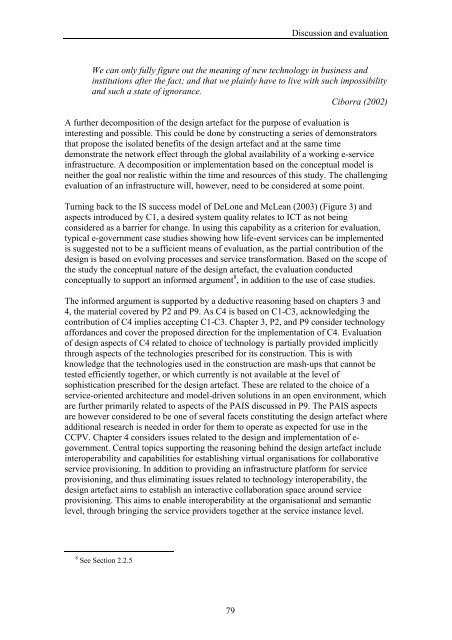Multi-channel provisioning of public services - Department of ...
Multi-channel provisioning of public services - Department of ...
Multi-channel provisioning of public services - Department of ...
You also want an ePaper? Increase the reach of your titles
YUMPU automatically turns print PDFs into web optimized ePapers that Google loves.
Discussion and evaluation<br />
We can only fully figure out the meaning <strong>of</strong> new technology in business and<br />
institutions after the fact; and that we plainly have to live with such impossibility<br />
and such a state <strong>of</strong> ignorance.<br />
Ciborra (2002)<br />
A further decomposition <strong>of</strong> the design artefact for the purpose <strong>of</strong> evaluation is<br />
interesting and possible. This could be done by constructing a series <strong>of</strong> demonstrators<br />
that propose the isolated benefits <strong>of</strong> the design artefact and at the same time<br />
demonstrate the network effect through the global availability <strong>of</strong> a working e-service<br />
infrastructure. A decomposition or implementation based on the conceptual model is<br />
neither the goal nor realistic within the time and resources <strong>of</strong> this study. The challenging<br />
evaluation <strong>of</strong> an infrastructure will, however, need to be considered at some point.<br />
Turning back to the IS success model <strong>of</strong> DeLone and McLean (2003) (Figure 3) and<br />
aspects introduced by C1, a desired system quality relates to ICT as not being<br />
considered as a barrier for change. In using this capability as a criterion for evaluation,<br />
typical e-government case studies showing how life-event <strong>services</strong> can be implemented<br />
is suggested not to be a sufficient means <strong>of</strong> evaluation, as the partial contribution <strong>of</strong> the<br />
design is based on evolving processes and service transformation. Based on the scope <strong>of</strong><br />
the study the conceptual nature <strong>of</strong> the design artefact, the evaluation conducted<br />
conceptually to support an informed argument 8 , in addition to the use <strong>of</strong> case studies.<br />
The informed argument is supported by a deductive reasoning based on chapters 3 and<br />
4, the material covered by P2 and P9. As C4 is based on C1-C3, acknowledging the<br />
contribution <strong>of</strong> C4 implies accepting C1-C3. Chapter 3, P2, and P9 consider technology<br />
affordances and cover the proposed direction for the implementation <strong>of</strong> C4. Evaluation<br />
<strong>of</strong> design aspects <strong>of</strong> C4 related to choice <strong>of</strong> technology is partially provided implicitly<br />
through aspects <strong>of</strong> the technologies prescribed for its construction. This is with<br />
knowledge that the technologies used in the construction are mash-ups that cannot be<br />
tested efficiently together, or which currently is not available at the level <strong>of</strong><br />
sophistication prescribed for the design artefact. These are related to the choice <strong>of</strong> a<br />
service-oriented architecture and model-driven solutions in an open environment, which<br />
are further primarily related to aspects <strong>of</strong> the PAIS discussed in P9. The PAIS aspects<br />
are however considered to be one <strong>of</strong> several facets constituting the design artefact where<br />
additional research is needed in order for them to operate as expected for use in the<br />
CCPV. Chapter 4 considers issues related to the design and implementation <strong>of</strong> e-<br />
government. Central topics supporting the reasoning behind the design artefact include<br />
interoperability and capabilities for establishing virtual organisations for collaborative<br />
service <strong>provisioning</strong>. In addition to providing an infrastructure platform for service<br />
<strong>provisioning</strong>, and thus eliminating issues related to technology interoperability, the<br />
design artefact aims to establish an interactive collaboration space around service<br />
<strong>provisioning</strong>. This aims to enable interoperability at the organisational and semantic<br />
level, through bringing the service providers together at the service instance level.<br />
8 See Section 2.2.5<br />
79
















